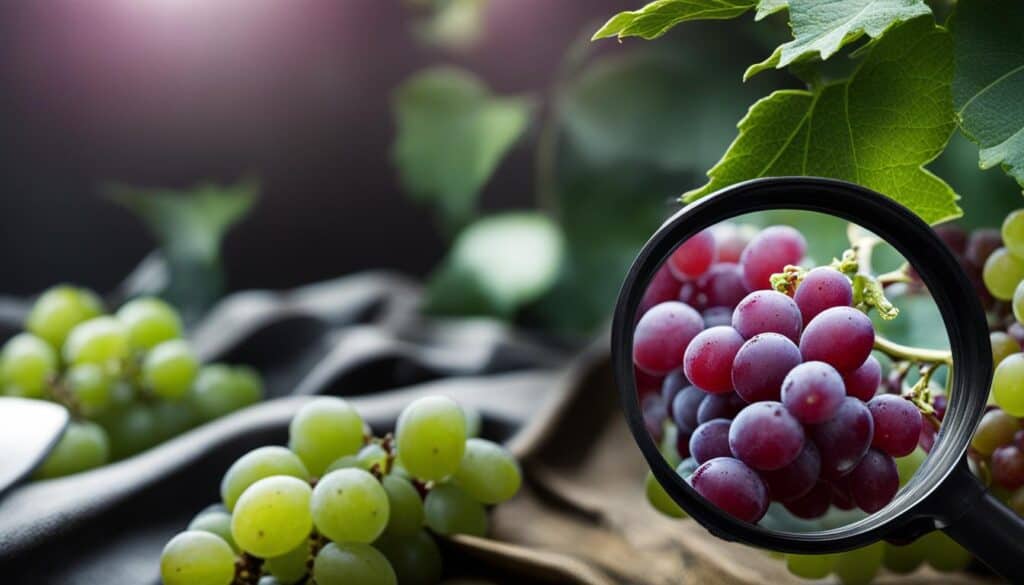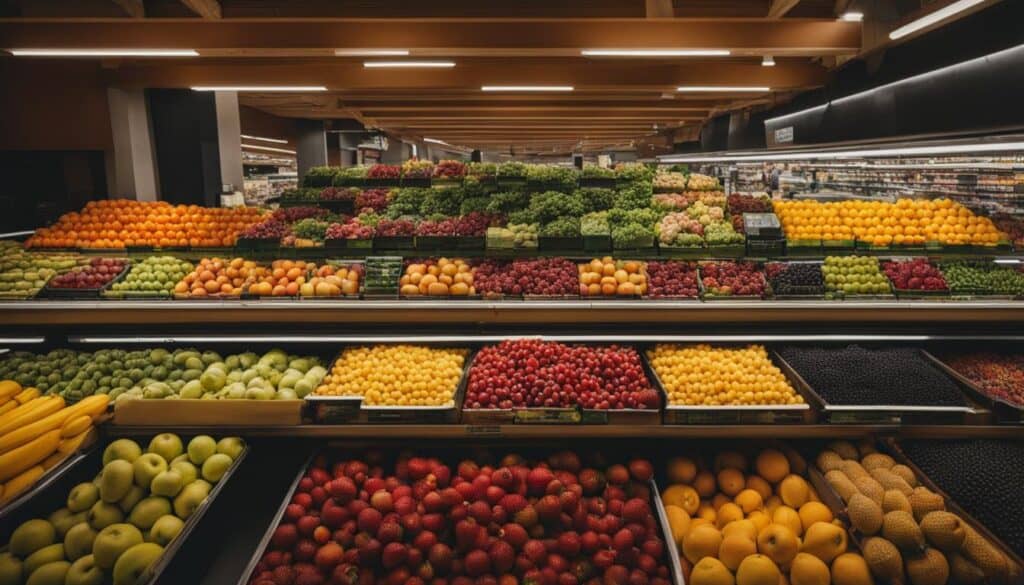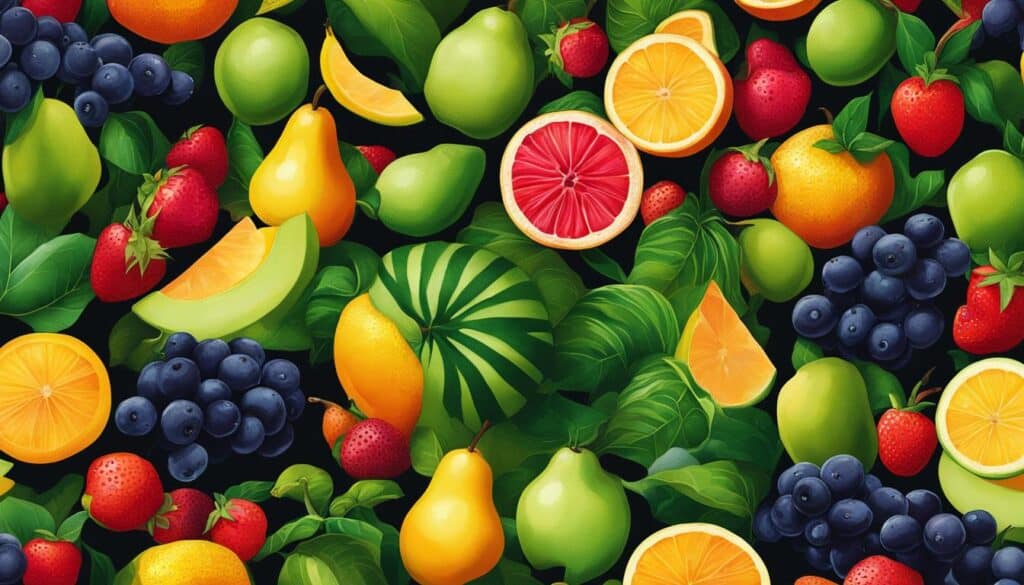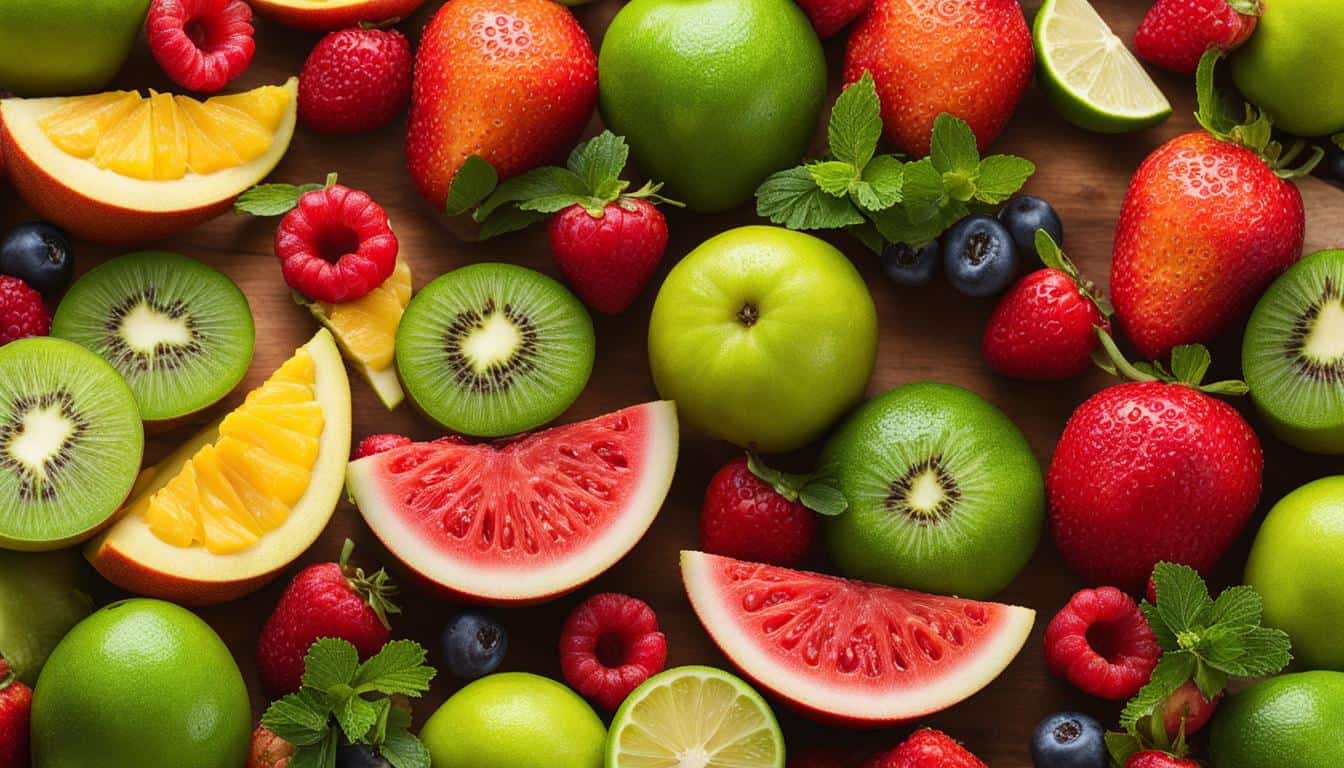Greetings! I’m here to take you on a delightful journey through the fascinating world of seedless fruit. Have you ever wondered about the wonders of fruit without those pesky little seeds? Well, you’re in for a treat! In this article, we will unravel the mysteries surrounding seedless fruit, debunk common myths, and explore the benefits they offer.
Key Takeaways:
- Seedless fruits are the result of natural or human-induced processes known as parthenocarpy.
- Contrary to popular belief, seedless fruits have minimal nutritional differences compared to their seeded counterparts.
- Seedless fruit production can impact biodiversity and the environment, as they rely heavily on cloning and may reduce genetic diversity.
- Consumer demand for uniformity and convenience has fueled the popularity of seedless fruits, but it is important to consider the long-term implications.
- To ensure a sustainable future, it is vital to support diverse fruit varieties and environmentally-friendly farming practices.
What Are Seedless Fruits?
Seedless fruits are a fascinating phenomenon in the world of botany. These fruits, which lack the typical seeds found in their counterparts, are the result of a biological process known as parthenocarpy. During parthenocarpy, the fruit develops without prior fertilization, resulting in a seedless variety. While some seedless fruits are a result of human intervention and genetic manipulation, such as Thompson Seedless grapes and modern seedless watermelons, many occur naturally in the wild.
One example of a naturally occurring seedless fruit is the banana. Bananas were spread around the world by early humans, who discovered a naturally hybridized variety that was seedless. This discovery allowed for the widespread cultivation and consumption of bananas, showcasing the potential benefits of seedless fruits.
Genetically sterile hybrids are another type of seedless fruit. These fruits are created through controlled breeding and genetic manipulation. By crossing different varieties and selectively breeding for desired traits, scientists can create sterile hybrids that produce fruit without seeds. This allows for the production of seedless fruits like seedless grapes and seedless oranges, which can be enjoyed by consumers without the inconvenience of seed removal.
Seedless fruit can also occur naturally through factors like self-sterility or chemical interventions. Some plants have mechanisms that prevent self-fertilization, resulting in fruit without seeds. Additionally, chemical treatments can be used to induce seedless fruit development in certain plants. These methods provide alternative ways for seedless fruits to exist in nature.
The Controversy Surrounding Seedless Fruits

Seedless fruits have been a subject of controversy, with debates surrounding their nutritional value and ethical concerns. Some individuals believe that seedless fruits are lower in nutritional value compared to their seeded counterparts. There are also religious perspectives that argue seedless fruit goes against teachings of the Bible, which emphasizes the importance of seeds for reproduction and sustenance.
However, research indicates that the nutritional difference between seedless and seeded fruits is minimal. Both types of fruits provide essential vitamins, minerals, and antioxidants that contribute to a healthy diet. Seedless fruits also offer convenience and ease of consumption, making them popular among consumers. Additionally, the absence of seeds in seedless fruits can make them more appealing to individuals who prefer certain textures or who have difficulty chewing or digesting seeds.
From an ethical standpoint, concerns have been raised about the impact of seedless fruit production on genetic diversity and long-term sustainability. Seedless fruits typically rely on cloning and sterile reproduction methods, which limit genetic variability within fruit species. This lack of genetic diversity can make plants more vulnerable to diseases and pests, posing challenges to fruit production in the future. It is important to consider these ethical concerns and explore sustainable practices that support a diverse range of fruit varieties and promote long-term food security.
Quotes:
“Seedless fruits provide convenience and ease of consumption, making them popular among consumers.”
“It is important to consider the impact of seedless fruit production on genetic diversity and long-term sustainability.”
Table: Nutritional Comparison of Seedless and Seeded Fruits
| Nutrient | Seedless Fruit | Seeded Fruit |
|---|---|---|
| Vitamin C | High | High |
| Fiber | Varies | Varies |
| Antioxidants | Varies | Varies |
While the exact nutrient composition may vary among different fruit varieties, both seedless and seeded fruits provide essential nutrients for a balanced diet. It is recommended to consume a variety of fruits to ensure a diverse intake of nutrients.
How Do Seedless Fruits Reproduce?
In order to understand how seedless fruits reproduce, we must first explore the process of fruit fertilization. In traditional fruit plants, fertilization occurs through the transfer of pollen from a male plant to the ovule of a female plant, which then leads to the development of seeds. However, seedless fruits have the unique ability to reproduce without the formation of seeds.
This reproductive phenomenon is known as parthenocarpy, which involves the development of a fruit without prior fertilization. Parthenocarpy can occur naturally in some plants or be induced through genetic crossing or hormonal interventions in others. It is important to note that not all seedless fruits are a result of human intervention; many occur naturally in the wild.
Polyploidy, a condition where plants have multiple copies of each chromosome, also plays a role in the production of seedless fruits. This genetic condition can lead to the development of fruits without seeds. Additionally, seedless fruits are often propagated through cloning, which involves reproducing plants by taking cuttings from a parent plant and growing identical copies.
Types of Seedless Fruit Reproduction
Seedless fruits can reproduce through various methods, including:
- Parthenocarpy: Development of fruits without fertilization.
- Polyploidy: Presence of multiple copies of chromosomes leading to seedless fruit development.
- Cloning: Propagation of seedless fruits by reproducing identical copies through cuttings from parent plants.
These reproductive mechanisms contribute to the fascinating world of seedless fruit, offering us a range of unique varieties to enjoy. However, it is important to consider the implications of these reproduction methods on genetic diversity and the long-term sustainability of fruit species.
Pros and Cons of Seedless Fruits
Seedless fruits offer several benefits that make them popular among consumers. One of the main advantages is convenience. Without the need to remove seeds, seedless fruits are easier and quicker to consume, making them a convenient option for busy individuals. Additionally, seedless fruits often have an extended shelf life compared to their seeded counterparts. This means that they can stay fresh for longer periods, reducing food waste and increasing the overall value for consumers.
For growers and sellers, seedless fruits can be more commercially valuable. With their uniform appearance and consistent taste, seedless varieties are often easier to sell and attract higher prices in the market. This can be beneficial for farmers who rely on the profitability of their crops.
However, it is important to consider the drawbacks of seedless fruits as well. One of the main disadvantages is the higher cost. Seedless fruits tend to be more expensive than their seeded counterparts due to the complex breeding and cultivation processes involved. The additional labor and resources required to produce seedless fruits contribute to their higher price tag.
“Seedless fruits offer convenience and an extended shelf life. They are easier to consume and can stay fresh for longer periods. However, they tend to be more expensive than seeded fruits due to the complex breeding and cultivation processes involved.”
Another concern is the impact on genetic diversity. Seedless fruits are often propagated through cloning, which limits the genetic variability within fruit species. This lack of diversity can make plants more susceptible to diseases and pests, posing a threat to their long-term viability. It is important to prioritize genetic diversity to ensure the resilience and adaptability of fruit species in the face of changing environmental conditions.
| Pros of Seedless Fruits | Cons of Seedless Fruits |
|---|---|
| Convenience for consumers | Higher cost compared to seeded fruits |
| Extended shelf life | Limited genetic diversity |
| Easier to sell and higher commercial value | Potential susceptibility to diseases and pests |
Overall, while seedless fruits offer convenience and commercial benefits, it is important to carefully consider their impact on genetic diversity and the environment. By making informed choices and supporting a diverse range of fruit varieties, we can strike a balance between consumer preferences and long-term sustainability.
The Impact on Biodiversity and Sustainability

When it comes to seedless fruits, there are important considerations to be made regarding their impact on biodiversity and sustainability. As these fruits are often propagated through cloning, they lack the genetic diversity found in traditional fruit plants. This limitation can have detrimental effects on the health and resilience of fruit species, making them more vulnerable to diseases and pests.
Furthermore, the production and transportation of seedless fruits can contribute to environmental issues. Many seedless fruits are imported from faraway places, resulting in increased fuel consumption and greenhouse gas emissions. This puts a strain on our already fragile ecosystems and exacerbates the effects of climate change.
To address these concerns, it is crucial to prioritize the preservation of genetic diversity in fruit species. By supporting sustainable farming practices and promoting the consumption of a wide variety of fruits, we can help maintain a healthy and resilient ecosystem. It is also essential to explore alternative methods of fruit propagation that promote genetic diversity and reduce environmental impact.
The Importance of Biodiversity in Fruit Species
Biodiversity plays a crucial role in the long-term survival of fruit species. Genetic variation allows plants to adapt to changing environmental conditions, resist diseases, and fend off pests. It also ensures that there is a diverse range of fruits available to meet the nutritional needs of different populations.
“Preserving genetic diversity in fruit species is essential for maintaining healthy ecosystems and ensuring food security for future generations.”
However, the reliance on seedless fruits, which lack genetic diversity, puts these species at risk. Without the ability to reproduce naturally through seeds, these fruits become more susceptible to genetic disorders and are less capable of adapting to new challenges. This can have significant implications for both farmers and consumers.
A Call for Sustainable Practices in Fruit Production
To mitigate the impact of seedless fruit production on biodiversity and the environment, sustainable practices must be adopted. This includes embracing alternative methods of fruit propagation, such as hybridization and selective breeding, that prioritize genetic diversity. Additionally, reducing the reliance on imported seedless fruits and supporting local, organic farming can minimize the carbon footprint associated with their production and transportation.
“Choosing locally grown, diverse fruits can make a positive impact on the environment and support sustainable farming practices.”
By promoting biodiversity and sustainable farming practices, we can ensure the long-term viability of fruit species while minimizing the environmental impact of seedless fruit production. It is up to consumers, farmers, and policymakers to embrace these practices and make informed choices that prioritize both the health of our ecosystems and the availability of nutritious fruits for future generations.
The Truth About Consumer Demand

When it comes to seedless fruit, consumer demand has played a significant role in its rising popularity. People are drawn to the convenience and consistent texture that seedless fruit offers. In a world where standardization is prioritized, seedless varieties have become a preferred choice for many.
Consumers often seek uniformity in their fruit purchases, and seedless options align with this desire. Whether it’s a bunch of seedless grapes or a watermelon without those pesky black seeds, seedless fruit appeals to those looking for a hassle-free eating experience. It eliminates the need for seed removal, making it a convenient choice for snacks and recipes.
However, it is important to consider the repercussions of catering primarily to consumer demands for seedless fruit. While it may seem like a harmless preference, it can impact the genetic diversity of fruit species and the sustainability of our food system. By focusing on one type of fruit variety, we limit the range of flavors, textures, and nutritional profiles available to us.
The Standardization of Fruits
The standardization of fruits has contributed to the rise of seedless varieties in the market. As profit-oriented marketing strategies promote uniformity, seedless fruits align with this approach. They provide a consistent product that meets consumer expectations and increases sales.
“We have seen a shift towards the production of seedless fruits as they are more likely to meet consumer demand for consistent quality and texture,” says Dr. Sarah Thompson, a horticultural expert. “However, we need to strike a balance between consumer preferences and the preservation of genetic diversity in our fruit crops.”
By considering a wider range of fruit varieties, we can support genetic diversity and ensure the long-term viability of fruit species. This approach allows for greater adaptability to environmental changes and safeguards against the risks associated with monoculture farming practices.
| Advantages of Seedless Fruit | Disadvantages of Seedless Fruit |
|---|---|
| – Convenience for consumers | – Higher cost compared to seeded varieties |
| – Extended shelf life in some cases | – Reduced genetic diversity |
| – Ease of consumption | – Increased vulnerability to diseases and pests |
| – Increased commercial value for growers | – Lower fiber content compared to seeded varieties |
While seedless fruits offer several advantages, it is crucial to consider the potential drawbacks. The higher cost compared to seeded varieties can be a deterrent for some consumers. Furthermore, the reduced genetic diversity resulting from cloning can make plants more susceptible to diseases and pests.
It’s important to strike a balance between consumer demand and the preservation of genetic diversity. By supporting a diverse range of fruit varieties, we can enjoy the benefits of seedless fruit while ensuring the long-term sustainability of our food sources.
Seedless Fruits and Genetic Variability
Seedless fruits, with their unique characteristics and lack of seeds, have gained popularity among consumers. However, their sterile reproduction methods and reliance on cloning pose challenges to genetic variability within fruit species. Without the ability to reproduce naturally through seeds, these fruits limit the genetic diversity necessary for adaptation and resistance to diseases and environmental changes.
While seedless fruits offer convenience and uniformity, their sterile reproduction methods prevent the emergence of new traits and adaptations that could enhance the resilience and sustainability of fruit species. This lack of genetic variability can make plants more susceptible to diseases and pests, increasing the risk of crop loss and challenging the long-term viability of these fruit varieties.
| Advantages of Seedless Fruits | Disadvantages of Seedless Fruits |
|---|---|
|
|
As we strive for a sustainable future, it is crucial to consider the impact of seedless fruit production on genetic variability and biodiversity. Supporting diverse fruit varieties and environmentally-friendly farming practices can help maintain the resilience of fruit species and contribute to a more sustainable food system for future generations.
The Importance of Genetic Diversity
Genetic diversity plays a vital role in the adaptability and survival of plant species. It allows plants to evolve and develop traits that help them thrive in different environments. By preserving and promoting genetic variability, we can ensure the long-term health and sustainability of fruit species.
Looking Towards a Sustainable Future

As we delve into the world of seedless fruits, it is crucial to consider the sustainability of their production and the implications for future food sources. While seedless fruits offer benefits such as convenience and extended shelf life, we must also address the environmental impact and genetic variability concerns associated with their cultivation.
Table: Impact of Seedless Fruit Production
| Environmental Impact | Genetic Variability |
|---|---|
| Seedless fruits often require long-distance transportation, contributing to increased fuel consumption and greenhouse gas emissions. | Seedless fruits rely on cloning and sterile reproduction, limiting genetic diversity and making plants more susceptible to diseases. |
| The cultivation of seedless fruits may result in the loss of natural habitats and biodiversity. | The lack of genetic variability in seedless fruits hinders their ability to adapt to changing environmental conditions. |
| Chemical interventions used in seedless fruit production can have harmful effects on the environment and human health. | The reduced genetic diversity of seedless fruits reduces their ability to provide resilience against pests, diseases, and climate change. |
It is imperative that we prioritize sustainable farming practices and encourage biodiversity in fruit production. By supporting local and organic agriculture, we can reduce the carbon footprint associated with seedless fruit transportation and limit the use of chemical interventions. Furthermore, promoting the consumption of a diverse range of fruits, both seedless and seeded, can help maintain genetic variability and ensure future food security.
As consumers, we have the power to make informed choices and advocate for sustainable practices. By embracing variety and supporting environmentally-friendly fruit cultivation, we can contribute to a healthier, more sustainable future for our food sources and the generations to come.
The Impact on Biodiversity and Sustainability

When it comes to seedless fruits, there are important considerations to be made regarding their impact on biodiversity and sustainability. These fruits, which are dependent on cloning for propagation, pose a threat to the genetic diversity of fruit species. With limited genetic variability, plants become more vulnerable to diseases and pests, ultimately impacting the overall health of ecosystems. Therefore, it is crucial that we take steps to preserve and protect biodiversity in our food system.
Furthermore, the production and transportation of seedless fruits can have significant environmental implications. Many seedless fruits are imported from faraway places, leading to increased fuel consumption and greenhouse gas emissions. As we strive for a more sustainable future, it is necessary to evaluate the environmental impact of our food choices. By supporting locally grown and seasonal fruits, we can reduce the carbon footprint associated with seedless fruit production.
Additionally, promoting biodiversity in our fruit consumption is essential for long-term food security. Relying heavily on a single variety of seedless fruit can be risky if disease or pests target that specific variety. By embracing a diverse range of fruit varieties, we ensure that our food system remains resilient and capable of adapting to changing conditions. It is important to remember that our choices as consumers can greatly influence the sustainability and future availability of diverse fruit species.
As we navigate the world of seedless fruits, it is crucial to consider their impact on biodiversity and sustainability. By supporting genetic variability, making environmentally conscious choices, and embracing diverse fruit varieties, we can contribute to a healthier and more sustainable food system. Let us strive for a future where seedless fruits coexist harmoniously with biodiversity and ensure the long-term availability of nutritious fruits for generations to come.
Conclusion
In conclusion, seedless fruits have gained popularity among consumers due to their convenience and perceived benefits. While there are some concerns surrounding their nutritional value, research indicates that the differences between seedless and seeded fruits are minimal. However, it is important to consider the impact of seedless fruit production on genetic diversity, sustainability, and the environment.
Seedless fruits, by their very nature, lack the ability to reproduce naturally through seeds, which limits genetic variability and can make plants more vulnerable to diseases. Additionally, the production and transportation of seedless fruits can have a significant environmental impact. To ensure a healthier and more sustainable future, it is crucial to make informed choices and support a diverse range of fruit varieties.
By embracing biodiversity, supporting environmentally-friendly farming practices, and encouraging the consumption of a variety of fruits, we can contribute to a more sustainable food system. It is up to us to protect genetic diversity, prioritize sustainability, and make choices that benefit both our health and the environment. Let’s work towards a future where our food sources are diverse, resilient, and abundant for generations to come.
FAQ
Are seedless fruits less nutritious than seeded fruits?
No, the nutritional difference between seeded and seedless fruits is minimal. Seedless fruits offer similar health benefits and can be part of a balanced diet.
How do seedless fruits reproduce if they don’t have seeds?
Seedless fruits are often reproduced through cloning, which involves taking cuttings from existing plants and growing them into new ones.
Are seedless fruits more expensive than seeded fruits?
Yes, seedless fruits tend to be more expensive due to the additional efforts and techniques required for their production.
Do seedless fruits have a longer shelf life?
While some seedless fruits may have a slightly longer shelf life, it ultimately depends on the specific fruit and its ripeness at the time of purchase.
Do seedless fruits have lower fiber content?
Some seedless fruits may have slightly lower fiber content compared to seeded varieties, but the overall difference is usually insignificant.
What is the impact of seedless fruit production on biodiversity?
Seedless fruit production limits genetic diversity within fruit species, making them more vulnerable to diseases and environmental changes.
What is the environmental impact of seedless fruit production?
Seedless fruits are often imported from faraway places, contributing to increased fuel consumption and greenhouse gas emissions. Additionally, the cloning process used for propagation can reduce genetic diversity and impact ecosystems.
How does consumer demand affect the availability of seedless fruits?
Consumer demand for uniformity and convenience has led to the increased popularity of seedless fruits. However, it is important to consider the potential health and sustainability implications of primarily catering to these preferences.
Why is genetic variability important for fruit species?
Genetic variability allows plants to adapt to changing environmental conditions and resist diseases and pests. Without it, fruit species become more vulnerable and may struggle to survive in the long term.
What can we do to ensure a sustainable future for seedless fruits?
By supporting environmentally-friendly farming practices, embracing biodiversity, and encouraging the consumption of a variety of fruits, we can work towards a more sustainable future for our food system.





Leave a Reply